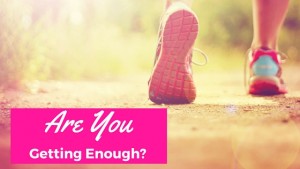Probably not. Most of us don’t. Cars, the convenience of online shopping, the weather, it all means we don’t get as much time walking as we should.
Yes, walking. What did you think I was talking about? Ok I’m sorry, but it’s not easy making a blog on walking sound exciting.
Because most people don’t think of walking as exciting.
It’s not a sexy form of exercise. You don’t see people boasting about their walking personal best like a runner does, or the killer spin/ Insanity/ whatever class is on trend and torturing you right now. (Sorry, I shouldn’t say that, I used to teach indoor cycling and don’t really consider it torture. Not once you’ve got used to the seats at least.)
But walking is the most underrated form of exercise.
And we really don’t get enough. One study found 80% of adults didn’t even manage to take moderate exercise 3 times a week, and just 25 minutes of brisk walking a day can add up to seven years to your life. (ok, this is getting a bit boring now; no more health stats).
Walking is a fundamental movement of the human body.
As well as not doing enough of it, a lot of what we do is poor quality walking (I’ll talk more about this in my next blog), and it has so many benefits. I cannot emphasise enough how awesome walking is.
Walking works your pelvic floor
The pelvic floor loves movement; a sedentary lifestyle is one of the worst things for it. Watch this to see how regular walking engages your pelvic floor:
It gets those glutes working!
Too much sitting results in weak, ineffective butt muscles. Walking is a great way to strengthen them. Walk, and walk often, making sure they’re engaging properly. Make sure you’re pushing back with them, not just flopping forward from one leg to another. Have a feel- place your hands on your buttocks and see if you can feel them tense up as you land on each leg (don’t worry, this won’t look weird at all), then try and drive your eg back and use them to push yourself forwards.
Walk your way to more vitamin D
Not all walking is created equal, and walking on a treadmill is NOT the same as getting outdoors (more on this in the next blog). And when you’re outside, you get your daily dose of vitamin D. A LOT of adults are deficient in this, and interestingly it’s been linked to pelvic floor dysfunction, so yet another benefit to your pelvic floor!
Walking is fantastic postnatal exercise
It has none of the risks that some exercises (such as running) carry for vulnerable joints and pelvic floor muscles, when done properly uses a huge number of muscles, and it is one of the few exercises that is easily done with baby. In fact it’s great for babies to get outside, and increased sunlight has been linked to better night time sleep for them!
Add to that reduced stress, especially in natural settings, the chance to think (or not think if you need a bit of mindfulness), the benefits to the glutes and pelvic floor- this is why daily walking is part of the homework for mums on Restore My Core.
It’s easy to fit in
It’s so easy to spend your day rushing around and busy, but never really moving. A lot of people struggle to find the time to go to the gym or follow a more structured exercise routine, but it’s so easy to fit in some walks. Because walking serves a purpose: getting from A to B. Even if it’s just parking a bit further from your destination, start to build a bit more ambulation into your day.
How much do you need?
This depends on a bit on how much you’re getting now (I feel like I should be able to slip some puns in here). As with any exercise, build up slowly. But looking at how much our ancestors walked is a good guide to what we should be capable of.
In her book Move Your DNA, Katy Bowman says anthropolgists estimate hunter-gatherers walked about 1,000 miles a year. That’s 2.75 miles a day. BUT, this mileage wouldn’t have been broken down that neatly. There would be short walks spread throughout the day, along with days of very little walking and days with much longer walks.
The odd longer (10 mile) walk means you develop the strength and endurance in your muscles. The regular short walks mean you benefit from regular boosted circulation (‘feeding’ your cells and removing waste products) and regular breaks from too much sitting and all the negative adaptations that can bring.
10 miles might seem intimidating.
But how about signing up to an event like our local Starlight Walk? It’s 13 miles, but you’re raising money for a good cause, and there’s plenty of motivation and entertainment on the night. Something fun to aim for is the perfect excue to get started!
Next time I’m going to tell you how to pimp your walk (yep, still trying to make it sexy) and get the most from your daily amble. Because a lot of people are doing it wrong.
Not all walking is created equal, but with a few tweaks to your route, and the right stretches and exercises, you can make sure you maximise the benefits next time you head out for a stroll. Sign up for updates here to make sure you don’t miss it (and grab a couple of freebies while you’re at it).





I feel so much happier now I untesrdand all this. Thanks!